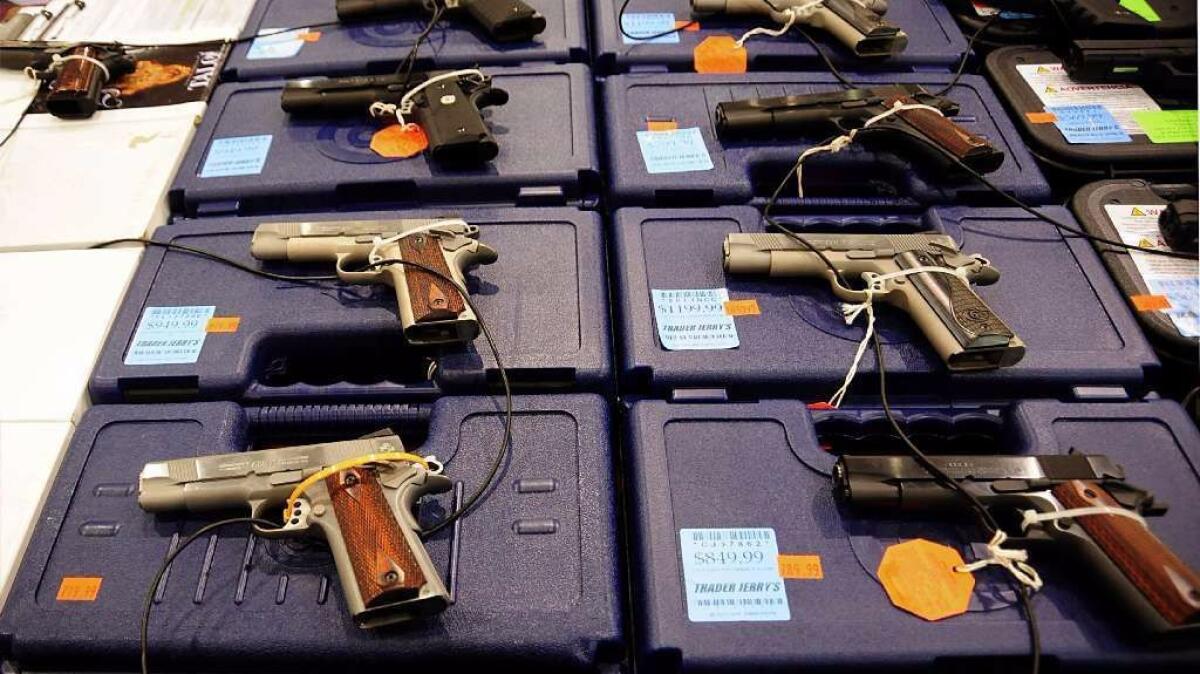Domestic violence homicide rate drops with stricter gun law, study finds

- Share via
When domestic violence offenders are required to relinquish their guns, instead of simply being barred from owning firearms, the risk that those offenders may kill their partners goes down, a new study finds.
The paper, described in the Annals of Internal Medicine, highlights a simple method for lowering the risk women face of being killed by an intimate partner: Enforce the laws already in place.
Each year, the study authors point out, more than 1,800 people are killed by their intimate partners — current or former spouses or people they dated, for example. About half of those killings are carried out with a gun.
Roughly 85% of those victims are women. In fact, nearly half of the women killed in the U.S. each year are killed not by a stranger, but by an intimate partner.
Firearms play a significant role in these domestic violence homicides — a pattern that the law has tried to address for decades. The 1994 Violence Against Women Act banned gun ownership for people with permanent restraining orders because of intimate-partner violence, or IPV. And a 1968 law banning gun ownership for those with an IPV-related felony was extended to include misdemeanors in 1996.
In theory, these laws should be enough; in practice, they’re hard to enforce on the federal level. So state laws have sprung up to fill in the gap.
The problem is, the state laws were modeled after the federal law, which has a gaping loophole: While offenders are not allowed to own a gun, they aren’t explicitly compelled by the law to give up any guns they already have.
Recently, some states have begun to change those laws, putting in additional requirements that IPV offenders actively relinquish their firearms. California is among those states, along with Hawaii, Massachusetts, New York, Wisconsin, North Carolina and several others.
But do any of the policies in this state-by-state patchwork quilt of gun legislation actually work? It’s been hard to tell because there hasn’t been much research on the effectiveness of different gun laws, said senior author Michael Siegel, an epidemiologist at the Boston University School of Public Health. Without a clear blueprint for what works and what doesn’t, it’s hard to craft good policy.
“It’s not so easy to say to states, ‘OK, here’s a set of policies that we need to pass, and if you pass these, it’ll work,’ ” Siegel said. “And I think the reason for that is that the NRA [National Rifle Association] has successfully blocked federal research on gun control for so many years.”
The Centers for Disease Control and Prevention has done minimal research on gun control since the 1997 Dickey Amendment, which banned the use of federal funds to “advocate for or promote gun control.” While not explicitly banning gun violence research, this provision coupled with budget appropriations has had a chilling effect on such work at the CDC.
(Former Republican congressman Jay Dickey from Arkansas, who authored the amendment and died earlier this year, later said he had deep regrets about the legislation and called for more gun-violence research.)
For this study, Siegel and his colleagues decided to use this patchwork of policies as a natural experiment. They compared the intimate-partner homicide rates from 1991 to 2015 for each state, using the FBI’s Uniform Crime Reports database. They looked at which states simply banned gun possession for people under IPV-related restraining orders, and which ones went a step further and required those people to actively turn in their firearms. They adjusted for such factors as each state’s violent crime rate (minus homicide), the incarceration rate, the percentage of gun-owning households, the poverty rate, the unemployment rate and the income level.
In states that simply banned gun possession, the gun-related intimate-partner homicide rate did not drop by a statistically significant amount. But in those that required offenders to surrender their guns, that rate dropped by a full 14%.
This drove the overall intimate-partner homicide rate down by 9.7% — which indicated that the laws really did seem to have a significant effect. Would-be offenders weren’t simply resorting to other means of killing now that they did not have a gun.
“This is actually saving people’s lives,” Siegel said.
The research highlights the importance of finding ways to effectively enforce laws that already exist, he added. After all, under either type of law, it is illegal for these offenders to own a gun — but only one compels those offenders to actually comply with that law.
In an editorial on the paper, Dr. Joslyn Fisher of Baylor College of Medicine in Houston and Amy Bonomi of Michigan State University in East Lansing called the paper a “timely study that informs a simmering national debate about firearm-related policy.”
“Taken together, these findings underscore the importance of firearm surrender within broader policy debates about domestic abuse,” they wrote.
Follow @aminawrite on Twitter for more science news and “like” Los Angeles Times Science & Health on Facebook.
MORE IN SCIENCE
Research on gun violence is severely underfunded compared with other causes of death
Gun violence kills 1,300 children each year and sends thousands more to hospitals







